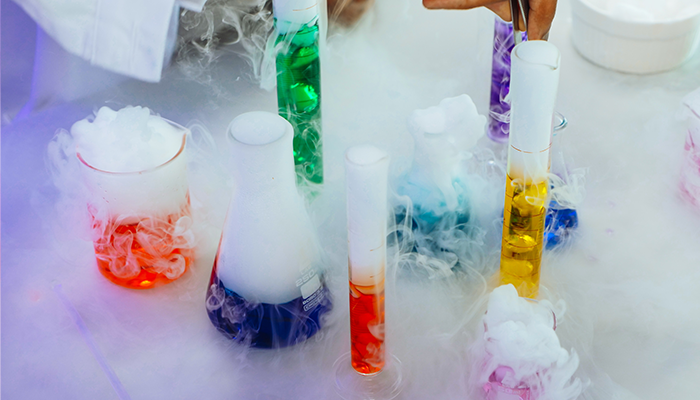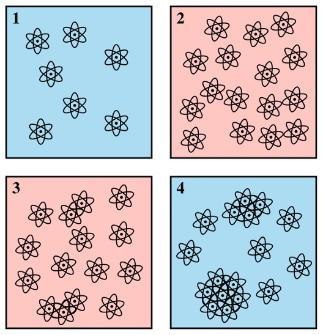Do you have what it takes to win? Of QUARTZ you do!
Get involved with our British Science Week competition and grow your own salt crystals.
The winner of the 'Grow Your Own Crystal' Competition will receive a goodie bag worth over £30. All you have to do is grow the biggest and brightest salt crystals following the recipe below, adding in your own experimental materials to make them spectacular! It's as easy as 1,2,3!
All entries must be received by 5pm on Wednesday 13 March with a winner being announced on Thursday 14 March, at the University of Lincoln's British Science Week event. Full terms and conditions can be found below.
Good luck!
The Recipe
Here’s a basic recipe (don’t forget to add your own ingredients such as food colouring to make the crystals big and bright):
1. Boil some water in a pan and slowly add salt. Please be careful and ask an adult to help you with this stage (unless you are an adult yourself).
At first, the salt will dissolve very quickly, but as you continue to add more it will eventually collect at the bottom of the pan which means the solution has become super-saturated.
2. Once you have a super-saturated solution, pour this into a glass container so you can easily see what is going on inside. Place it somewhere safe at room temperature.
3. Go away and do something that takes more than a day. For example, you could build a magnificent city like Rome, count to 86401, or walk from Lincoln to Coventry.
4. Go back to look at your solution. You should already see crystals being formed, but they will probably not be full size yet.
5. Repeat steps 3 and 4 until you have some nice big crystals!
6. Send us a photo! To submit your entry snap a photograph of your crystals grown from home and send them to us via email, DM or tag us on social media. Make sure to use the #UoLCrystals.
Entries can be made by photographing crystals grown at home and sending the photograph to the promoter either by email at cohsenquiries@lincoln.ac.uk or by posting the photograph on social media and tagging the College of Health and Science (Instagram @uolheath_science). Included channels are X, Facebook and Instagram.
Additional Tips
- It might be a good idea to give the nucleation a bit of a head-start by suspending something with a rough surface (like some string) in your solution during steps 3-5. Nucleation is more likely to occur in nooks and crannies of a surface than in the solution itself.
-
You may want to try avoiding the nucleation stage altogether and introduce ‘seed crystals’ to your cooled, super-saturated solution. Perform steps 1-5 above and choose a crystal with a large flat surface as your ‘seed’. Make a new super-saturated salt solution and add your seed immediately before step 3 once the solution has cooled to room temperature.
-
Impurities in the original salt can significantly alter the process. This can make the resulting crystals look more vibrant but can also hinder their formation. Experiment!
-
The shape and surface of the container may make a difference, so you may want to experiment with a few different types.

Terms and Conditions
- The promoter is the College of Health and Science, University of Lincoln.
- There is no entry fee to enter the competition.
- These terms and conditions apply to the “Grow your own Crystals” competition run by the College of Health and Science as part of British Science Week 2024.
- By entering this competition, an entrant is indicating their agreement to be bound by these terms and conditions.
- Entries can be made by photographing crystals grown at home and sending the photograph to the promoter either by email at cohsenquiries@lincoln.ac.uk or by posting the photograph on social media and tagging the College of Health and Science (Instagram @uolheath_science). Included channels are X, Facebook and Instagram.
- A winner will be chosen from the two ways in which submissions can be made, i.e., via email and social media.
- The winners will be announced on Thursday 14th March 2022 at Lincoln’s British Science Week Event.
- If a winner cannot attend Lincoln’s British Science Week event they will be contacted after the event in due course via the channel in which they chose to submit (i.e., X, Facebook, Instagram, or email).
- The winner will be awarded their goodie bag during Lincoln’s British Science Week event or sent via post.
- No alternative to the prizes will be offered.
- If the winner cannot be contacted or does not claim the prize within 14 days of notification, they will forfeit the prize.
- No responsibility can be accepted for entries not received for whatever reason.
- Winners will be chosen by a panel of academic staff at the College of Health and Science. The panel’s decision is final, and no correspondence will be entered into.
- The promoter’s decision in respect of all matters to do with the competition will be final and no correspondence will be entered into.
- The entrant agrees to the use of their photographic entry to be used in any publicity material and to feature on the University of Lincoln’s websites. Any personal data relating to the winner, or any other entrants will be used solely in accordance with current UK data protection legislation.
- The promoter reserves the right to cancel or amend the competition and these terms and conditions without notice at any time. Any changes to the competition will be notified to entrants as soon as possible by the promoter.
- The competition and these terms and conditions will be governed by English law and any disputes will be subject to the exclusive jurisdiction of the courts of England.
- The winner will be selected based on size and colourfulness of the crystals.
- The competition deadline is Wednesday 13th March at 5pm. Late Entries will not be counted.
Watch now for our step-by-step guide...
The Science: Nucleation and Growth of Salt Crystals
Any substance that has a highly ordered structure can be considered as a crystal. Typically, these are solid materials in which the atoms are arranged in a periodic and symmetrical manner.
It’s quite easy to form salt crystals at home from normal table salt dissolved in water… but it’s a bit trickier to form large ones! The salt that we add to our food (in sensible amounts) is made up of tiny little crystals. Rather than turn these small crystals directly into larger ones, we must first dissolve the salt in some water to form a salt solution (boxes 1 and 2), from which we can make larger crystals.
This process is split into two main phases: nucleation and growth. The nucleation stage is the appearance of clusters in which a small number of atoms locally assemble in a manner that resembles the arrangement of atoms found in large crystals (box 3). When additional atoms combine with the small clusters, they eventually grow into larger crystals (box 4).

For this process to work, it is important that you have a very high concentration of salt in your solution; the higher the concentration, the more favourable the ordered crystal structure becomes compared to the disordered salt solution. To make your salt solution as concentrated as possible, you must increase the temperature of the water while adding the salt (box 2). This makes what is known as a ‘super-saturated’ solution, which means that the solution contains more salt than it ‘usually’ would (i.e., at equilibrium). It is this supersaturation that is the main driver of the initial nucleation (box 3). If the salt concentration is high enough it becomes more favourable for the salt to form small clusters than to be in solution.
The final stage is the growth of these small clusters into large crystals (box 4). This should be done at room temperature and is a very slow process (it can take days!). Leave your solution in a cool place, away from any disturbances such as washing machines, drum kits, or helicopters.

.png)